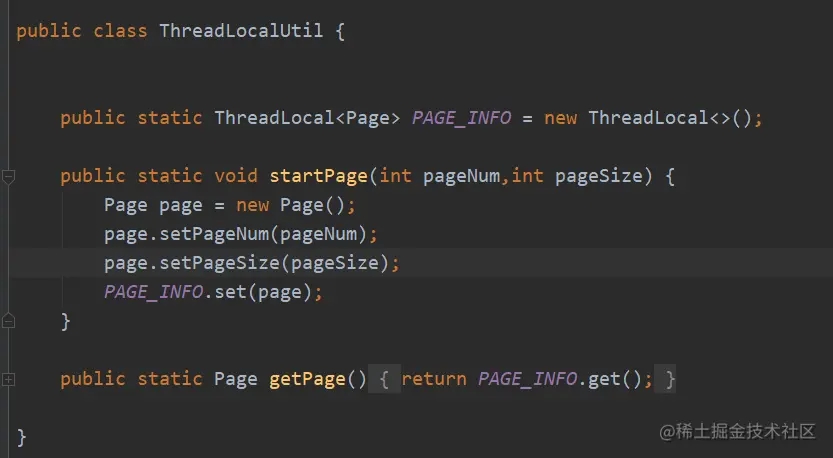Mybatis分頁插件PageHelper手寫實現示例
引言
PageHelper是一個非常好用的插件,以至於很想知道它底層是怎麼實現的。至於MyBatis插件概念原理網上有很多,我不太喜歡去寫一些概念性的東西,我比較喜歡自己動手實現的那種,話不多說,我們開幹
搭建一個SpringBoot+MyBatis+MySql項目
編寫我們的插件類
package com.example.demo.plugin;
import org.apache.ibatis.cache.CacheKey;
import org.apache.ibatis.executor.Executor;
import org.apache.ibatis.mapping.BoundSql;
import org.apache.ibatis.mapping.MappedStatement;
import org.apache.ibatis.plugin.*;
import org.apache.ibatis.session.ResultHandler;
import org.apache.ibatis.session.RowBounds;
import java.util.HashMap;
import java.util.List;
import java.util.Map;
import java.util.Properties;
@Intercepts(
{
@Signature(type = Executor.class,
method = "query",
args = {MappedStatement.class, Object.class, RowBounds.class, ResultHandler.class}),
@Signature(type = Executor.class,
method = "query",
args = {MappedStatement.class, Object.class, RowBounds.class, ResultHandler.class,
CacheKey.class, BoundSql.class}),
}
)
public class MyPagePlugin implements Interceptor {
@Override
public Object intercept(Invocation invocation) throws Throwable {
Object[] args = invocation.getArgs();
MappedStatement ms = (MappedStatement) args[0];
Object parameter = args[1];
RowBounds rowBounds = (RowBounds) args[2];
ResultHandler resultHandler = (ResultHandler) args[3];
Executor executor = (Executor) invocation.getTarget();
CacheKey cacheKey;
BoundSql boundSql;
//由於邏輯關系,隻會進入一次
if (args.length == 4) {
//4 個參數時
boundSql = ms.getBoundSql(parameter);
cacheKey = executor.createCacheKey(ms, parameter, rowBounds, boundSql);
} else {
//6 個參數時
cacheKey = (CacheKey) args[4];
boundSql = (BoundSql) args[5];
}
== 其實在這之上的代碼都是拷貝PageHelper源碼來的,下面才是重頭戲,上面都是獲取一些必要的參數==
/**
* 下面4行代碼暫時隻需要知道是用來傳參數的就行,分頁不是需要
* 二個參數嘛 一個是當前頁,一個是數量
*/
Page page = ThreadLocalUtil.getPage();
Map<String,Object> params = new HashMap<>();
params.put("first_key",page.getPageNum());
params.put("second_key",page.getPageSize());
/**
* 重點:獲取數據庫記錄總數
*/
//統計總數
Long count = MyExecutorUtil.executeAutoCount(executor,ms,parameter,boundSql,rowBounds,resultHandler);
/**
* 重點:分頁查詢
*/
List<Object> objects = MyExecutorUtil.pageQuery(executor, ms, parameter, rowBounds, resultHandler, boundSql, cacheKey, params);
return objects;
}
@Override
public Object plugin(Object target) {
return Plugin.wrap(target, this);
}
@Override
public void setProperties(Properties properties) {
}
}
上面有二個核心方法
1:獲取記錄總數:
MyExecutorUtil.executeAutoCount(executor,ms,parameter,boundSql,rowBounds,resultHandler);
2:分頁查詢:
MyExecutorUtil.pageQuery(executor, ms, parameter, rowBounds, resultHandler, boundSql, cacheKey,params);
獲取記錄總數
1:MyBatis源碼底層會封裝好我們在配置文件中寫的每一條SQL語句,封裝到一個SqlSource對象中去,在我們執行SQL的時候,會獲取到這條SQL,然後封裝到BoundSql這個對象中,所以在這裡,我們既然能拿到BoundSql,那麼也就意味著我們能拿到我們需要執行的那條Sql瞭

2:獲取到瞭我們的sql之後,怎麼查詢總記錄數呢??
其實很簡單,改Sql語句不就好瞭,Pagehelper底層也是這麼做的,但是PageHelper底層比我這個版本的復雜太多瞭,但是我們無非就是將原先的SQL轉換成 -> SELECT COUNT(0) FROM TABLE,就這樣,但是我這個人比較懶,而且昨天看這個源碼實現頭疼,所以在這裡直接寫死瞭,但是問題不大哈

3:改好瞭Sql之後是不是就完成瞭呢??
當然不是,改好瞭SQL當然是要去執行它瞭,如果就這樣執行,還是會執行原先的SQL,但是你要知道這個有個很關鍵的東西,就是MappedStatement的id,如果不改這個id的話,即使你的Sql能夠執行成功,那麼返回的記錄總數是個NULL,這裡我想可能是因為ResultSetHandle的關系,因為這個id對應的還是我們之前的sql,也就是select * from student,那麼必然有一個resultType的屬性,也就是實體類映射,但是我們現在的sql是select count(0) from student,那麼就對應不上瞭,也就是數據庫查詢出來的列與實體類對應不上,所以我們需要改變這個id。

//改變MapperStatement id的方法
public static MappedStatement newCountMappedStatement(MappedStatement ms, String newMsId) {
MappedStatement.Builder builder = new MappedStatement.Builder(ms.getConfiguration(), newMsId, ms.getSqlSource(), ms.getSqlCommandType());
builder.resource(ms.getResource());
builder.fetchSize(ms.getFetchSize());
builder.statementType(ms.getStatementType());
builder.keyGenerator(ms.getKeyGenerator());
if (ms.getKeyProperties() != null && ms.getKeyProperties().length != 0) {
StringBuilder keyProperties = new StringBuilder();
for (String keyProperty : ms.getKeyProperties()) {
keyProperties.append(keyProperty).append(",");
}
keyProperties.delete(keyProperties.length() - 1, keyProperties.length());
builder.keyProperty(keyProperties.toString());
}
builder.timeout(ms.getTimeout());
builder.parameterMap(ms.getParameterMap());
//count查詢返回值int
List<ResultMap> resultMaps = new ArrayList<ResultMap>();
ResultMap resultMap = new ResultMap.Builder(ms.getConfiguration(), ms.getId(), Long.class, EMPTY_RESULTMAPPING).build();
resultMaps.add(resultMap);
builder.resultMaps(resultMaps);
builder.resultSetType(ms.getResultSetType());
builder.cache(ms.getCache());
builder.flushCacheRequired(ms.isFlushCacheRequired());
builder.useCache(ms.isUseCache());
return builder.build();
}
4:MyBatis的Sql是封裝到BoundSql中去的,而原先的BoundSql中的Sql是我們配置文件中的,所以我們需要將select count(0) from student這條Sql語句封裝到一個新的BoundSql中去
public static Long executeAutoCount(Executor executor, MappedStatement countMs,
Object parameter, BoundSql boundSql,
RowBounds rowBounds, ResultHandler resultHandler) throws SQLException {
//改變MapperStatement中的ID屬性
String countMsId = countMs.getId() + "_COUNT";
countMs = newCountMappedStatement(countMs,countMsId);
//創建 count 查詢的緩存 key
CacheKey countKey = executor.createCacheKey(countMs, parameter, RowBounds.DEFAULT, boundSql);
//調用獲取count的sql
String countSql = "select count(0) from student";
//重新封裝BoundSql對象
BoundSql countBoundSql = new BoundSql(countMs.getConfiguration(), countSql, boundSql.getParameterMappings(), parameter);
//執行 count 查詢
List<Long> countResultList = executor.query(countMs, parameter, RowBounds.DEFAULT, resultHandler, countKey, countBoundSql);
Long count = countResultList.get(0);
return count;
}
5:最後調用executor.query方法就可以得到我們的記錄總數瞭
分頁查詢記錄數
- 1:其實分頁查詢與查詢記錄總數的原理是一樣的
- 2:首先獲取原先的BoundSql中的Sql,也就是我們在配置文件中的Sql,比如 select * from student
- 3:然後獲取我們的分頁參數,也就是前端傳遞過來的pageNum和pageSize二個參數
- 4:修改Sql,select * from student limit ?,?
- 5:這次我們就不用修改MapperStatement中的ID瞭,因為查詢出來的都是studnet,所以映射不用修改
- 6:重新實例化一個BoundSql對象,將新的Sql傳遞給它
- 7:最後執行executor.query方法查詢,得到結果
如何獲取前端傳遞過來的參數?
1:我這裡使用的是ThreadLocal,



總結
- 1:首選我們需要獲取到原先需要執行的sql
- 2:然後修改這條修改,分頁查詢無非就是總記錄數,分頁查詢的記錄數
- 3:分別執行這二條Sql,得到我們想要的結果
源碼:
就下面這5個類,其它的就是將SpringBoot+MyBatis+MySql日常配置就行瞭,然後再Controller記得傳遞一下參數

package com.example.demo.plugin;
import org.mybatis.spring.annotation.MapperScan;
import org.springframework.context.annotation.Bean;
import org.springframework.context.annotation.Configuration;
@Configuration
@MapperScan({"com.example.demo.mapper"})
public class MapperConfig {
@Bean
public MyPagePlugin myPagePlugin() {
return new MyPagePlugin();
}
}
package com.example.demo.plugin;
import com.example.demo.entity.Student;
import org.apache.ibatis.cache.CacheKey;
import org.apache.ibatis.executor.Executor;
import org.apache.ibatis.mapping.*;
import org.apache.ibatis.session.Configuration;
import org.apache.ibatis.session.ResultHandler;
import org.apache.ibatis.session.RowBounds;
import java.sql.SQLException;
import java.util.ArrayList;
import java.util.List;
import java.util.Map;
public class MyExecutorUtil {
private static final List<ResultMapping> EMPTY_RESULTMAPPING = new ArrayList<ResultMapping>(0);
public static <E> List<E> pageQuery(Executor executor, MappedStatement ms, Object parameter,
RowBounds rowBounds, ResultHandler resultHandler,
BoundSql boundSql, CacheKey cacheKey,Map<String,Object> params) throws SQLException {
executor.clearLocalCache();
//生成分頁的緩存 key
CacheKey pageKey = cacheKey;
//處理參數對象
if(params.size() < 0 || params.size() > 2) {
System.out.println("參數錯誤");
}
//獲取sql
String pageSql = getPageSql(params.size(),boundSql);
List<ParameterMapping> mappingList = new ArrayList<>();
mappingList.add(new ParameterMapping.Builder(ms.getConfiguration(), "first_key", Integer.class).build());
mappingList.add(new ParameterMapping.Builder(ms.getConfiguration(), "second_key", Integer.class).build());
//實例化新的BoundSql對象
BoundSql pageBoundSql = new BoundSql(ms.getConfiguration(), pageSql, mappingList, params);
//執行分頁查詢
return executor.query(ms, params, RowBounds.DEFAULT, resultHandler, pageKey, pageBoundSql);
}
public static Long executeAutoCount(Executor executor, MappedStatement countMs,
Object parameter, BoundSql boundSql,
RowBounds rowBounds, ResultHandler resultHandler) throws SQLException {
//改變MapperStatement中的ID屬性
String countMsId = countMs.getId() + "_COUNT";
countMs = newCountMappedStatement(countMs,countMsId);
//創建 count 查詢的緩存 key
CacheKey countKey = executor.createCacheKey(countMs, parameter, RowBounds.DEFAULT, boundSql);
//調用獲取count的sql
String countSql = "select count(0) from student";
//重新封裝BoundSql對象
BoundSql countBoundSql = new BoundSql(countMs.getConfiguration(), countSql, boundSql.getParameterMappings(), parameter);
//執行 count 查詢
List<Long> countResultList = executor.query(countMs, parameter, RowBounds.DEFAULT, resultHandler, countKey, countBoundSql);
Long count = countResultList.get(0);
return count;
}
public static MappedStatement newCountMappedStatement(MappedStatement ms, String newMsId) {
MappedStatement.Builder builder = new MappedStatement.Builder(ms.getConfiguration(), newMsId, ms.getSqlSource(), ms.getSqlCommandType());
builder.resource(ms.getResource());
builder.fetchSize(ms.getFetchSize());
builder.statementType(ms.getStatementType());
builder.keyGenerator(ms.getKeyGenerator());
if (ms.getKeyProperties() != null && ms.getKeyProperties().length != 0) {
StringBuilder keyProperties = new StringBuilder();
for (String keyProperty : ms.getKeyProperties()) {
keyProperties.append(keyProperty).append(",");
}
keyProperties.delete(keyProperties.length() - 1, keyProperties.length());
builder.keyProperty(keyProperties.toString());
}
builder.timeout(ms.getTimeout());
builder.parameterMap(ms.getParameterMap());
//count查詢返回值int
List<ResultMap> resultMaps = new ArrayList<ResultMap>();
ResultMap resultMap = new ResultMap.Builder(ms.getConfiguration(), ms.getId(), Long.class, EMPTY_RESULTMAPPING).build();
resultMaps.add(resultMap);
builder.resultMaps(resultMaps);
builder.resultSetType(ms.getResultSetType());
builder.cache(ms.getCache());
builder.flushCacheRequired(ms.isFlushCacheRequired());
builder.useCache(ms.isUseCache());
return builder.build();
}
private static String getPageSql(int paramsLength,BoundSql boundSql){
StringBuilder str = new StringBuilder();
str.append(boundSql.getSql());
if(paramsLength == 1) {
str.append(" LIMIT ?");
}else {
str.append(" LIMIT ?,? ");
}
return str.toString();
}
}
package com.example.demo.plugin;
import org.apache.ibatis.cache.CacheKey;
import org.apache.ibatis.executor.Executor;
import org.apache.ibatis.mapping.BoundSql;
import org.apache.ibatis.mapping.MappedStatement;
import org.apache.ibatis.plugin.*;
import org.apache.ibatis.session.ResultHandler;
import org.apache.ibatis.session.RowBounds;
import java.util.HashMap;
import java.util.List;
import java.util.Map;
import java.util.Properties;
@Intercepts(
{
@Signature(type = Executor.class,
method = "query",
args = {MappedStatement.class, Object.class, RowBounds.class, ResultHandler.class}),
@Signature(type = Executor.class,
method = "query",
args = {MappedStatement.class, Object.class, RowBounds.class, ResultHandler.class,
CacheKey.class, BoundSql.class}),
}
)
public class MyPagePlugin implements Interceptor {
@Override
public Object intercept(Invocation invocation) throws Throwable {
Object[] args = invocation.getArgs();
MappedStatement ms = (MappedStatement) args[0];
Object parameter = args[1];
RowBounds rowBounds = (RowBounds) args[2];
ResultHandler resultHandler = (ResultHandler) args[3];
Executor executor = (Executor) invocation.getTarget();
CacheKey cacheKey;
BoundSql boundSql;
//由於邏輯關系,隻會進入一次
if (args.length == 4) {
//4 個參數時
boundSql = ms.getBoundSql(parameter);
cacheKey = executor.createCacheKey(ms, parameter, rowBounds, boundSql);
} else {
//6 個參數時
cacheKey = (CacheKey) args[4];
boundSql = (BoundSql) args[5];
}
Page page = ThreadLocalUtil.getPage();
Map<String,Object> params = new HashMap<>();
params.put("first_key",page.getPageNum());
params.put("second_key",page.getPageSize());
//統計總數
Long count = MyExecutorUtil.executeAutoCount(executor,ms,parameter,boundSql,rowBounds,resultHandler);
System.out.println("count = " + count);
List<Object> objects = MyExecutorUtil.pageQuery(executor, ms, parameter, rowBounds, resultHandler, boundSql, cacheKey, params);
return objects;
}
@Override
public Object plugin(Object target) {
return Plugin.wrap(target, this);
}
@Override
public void setProperties(Properties properties) {
}
}
package com.example.demo.plugin;
public class Page {
private Integer pageNum;
private Integer pageSize;
public Integer getPageNum() {
return pageNum;
}
public void setPageNum(Integer pageNum) {
this.pageNum = pageNum;
}
public Integer getPageSize() {
return pageSize;
}
public void setPageSize(Integer pageSize) {
this.pageSize = pageSize;
}
}
package com.example.demo.plugin;
public class ThreadLocalUtil {
public static ThreadLocal<Page> PAGE_INFO = new ThreadLocal<>();
public static void startPage(int pageNum,int pageSize) {
Page page = new Page();
page.setPageNum(pageNum);
page.setPageSize(pageSize);
PAGE_INFO.set(page);
}
public static Page getPage() {
return PAGE_INFO.get();
}
}
@RestController
public class StudnetController {
@Autowired
private StudentMapper studentMapper;
@GetMapping("/getData")
public Object getData() {
ThreadLocalUtil.startPage(0,2);
return studentMapper.getData();
}
}
以上就是Mybatis分頁插件PageHelper手寫實現示例的詳細內容,更多關於Mybatis分頁插件PageHelper的資料請關註WalkonNet其它相關文章!
推薦閱讀:
- 解決mybatis分頁插件PageHelper導致自定義攔截器失效
- Mybatis第三方PageHelper分頁插件的使用與原理
- 詳解Mybatis的緩存
- MyBatis自定義SQL攔截器示例詳解
- MyBatis攔截器的實現原理